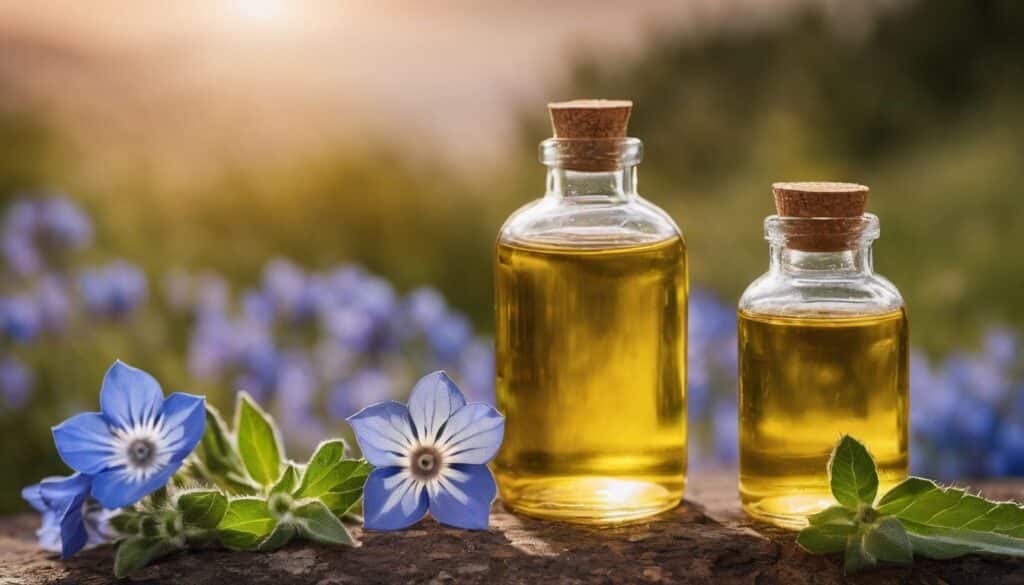Comparing Borage vs. Evening Primrose Oil: Which Is The Better Source Of GLA?

Are you searching for a natural solution to enhance your health and well-being? You may have stumbled upon two popular options: borage oil and evening primrose oil. Commonly sought after for their rich gamma-linolenic acid (GLA) content, these oils promise an array of medicinal benefits, leaving many to wonder which one reigns supreme as the source of this powerful fatty acid.
Borage oil notably boasts 2 to 3 times more GLA than evening primrose oil, making it a potent contender in wellness oils. Whether tackling hormonal imbalances or inflammatory conditions, understanding these differences can lead you to make an informed choice that best suits your health needs.
This blog unpacks the specifics – from GLA content comparisons and dosing instructions to contraindications and ways to integrate GLA into your diet. Dive deeper into plant-derived fatty acids; perhaps the key to unlocking better health is just a few drops away!
Key Takeaways
-
- Borage oil has more GLA than evening primrose oil, with about 17% to 25% GLA in borage compared to 7% to 10% in evening primrose.
-
- Both oils can help with hormone balance and inflammation. Borage might be better for inflammation because it has more GLA.
-
- Using these oils could cause side effects like stomach pain or increase the chance of bleeding. People should talk to doctors before using them, especially if they are pregnant or taking other medicines.
-
- The usual dose for borage oil is between 300 mg and 1000 mg daily, while evening primrose oil is usually taken at doses from 500 mg to 1300 mg daily.
-
- Other sources of GLA include hemp seeds, spirulina, chia seeds, flaxseeds, blackcurrant seed oil, and Ahiflower oil.
Understanding GLA and Its Benefits
Gamma linolenic acid (GLA) is an omega-6 fatty acid that offers various health benefits when used internally and externally. GLA plays a crucial role in the production of prostaglandins, which are hormone-like substances that help regulate inflammation, blood clotting, and other bodily functions.
Medical benefits of using GLA include treating conditions such as atopic eczema, reducing inflammation associated with rheumatoid arthritis, and promoting hormone balance.
What is gamma linolenic acid (GLA)?
Gamma linolenic acid, or GLA for short, is the body’s special fat to stay healthy. Our bodies do not make this fat, but it comes from plants. When we eat oils from borage seeds or flowers like evening primrose, we get GLA.
People say GLA helps with skin problems and can ease pain and swelling. It’s like a building block that our bodies turn into stuff that fights inflammation.
This oil gets turned into powerful helpers in our body called prostaglandins. They work like hormones to manage important jobs, including how your immune system acts and helping keep your skin and blood healthy.
Many folks are interested in taking oils rich in GLA to improve their health because they can do many good things.
Medical benefits of using GLA internally and externally
GLA is known for its power to help with skin problems and pain inside the body. If you take GLA, it can change into helpful things like prostaglandins. These substances work like a shield for your cells and calm inflammation, making you feel better if you have joint pain or skin issues.
Putting GLA on your skin can also do great things. It may strengthen your skin and help it hold water better, which means less dryness and irritation. People use creams with GLA to soothe their sensitive or upset skin, like when they have eczema or just dry patches.
Comparing Borage and Evening Primrose Oil

When comparing borage and evening primrose oil, it’s important to consider the GLA content in each oil and their respective medical benefits. Borage oil contains higher concentrations of GLA than evening primrose oil, making it a potentially more potent source of this essential fatty acid.
However, both oils have been shown to offer various health benefits, so understanding the specific advantages of each can help individuals make an informed decision about which supplement may be most beneficial for them.
GLA content in borage and evening primrose oil
Gamma linolenic acid, or GLA, is at the heart of many discussions about health and wellness, especially for those seeking to improve their health through natural oils. Before diving into the specifics, it’s essential to understand that GLA is a polyunsaturated fatty acid that plays a crucial role in maintaining the body’s balance and fighting inflammation. Borage and evening primrose oils are popular choices for increasing GLA intake, but they differ significantly in GLA content.
Borage oil, known for its impressively high GLA concentrations, is a robust supplement. Evening primrose oil is also valued but contains less GLA. To illustrate the differences and help you make an informed decision on which oil might be better for your health needs, let’s compare their GLA contents side by side in an easy-to-understand table format:
| Oil Type | GLA Content | Additional Notes |
| Borage Oil | 17% – 25% | Contains approximately 23% GLA; Considered the richest supplemental source of GLA. |
| Evening Primrose Oil | 7% – 10% | Lower GLA content than Borage; Still used for its health benefits. |
This table demonstrates the stark contrast in GLA content, with borage oil having two to three times the amount found in evening primrose oil. Such a difference can significantly impact your supplement choice, depending on your health goals and needs.
When considering these oils, it’s not just the amount of GLA that matters. Each one has unique properties and benefits, and the potential for side effects, toxicity, and interactions with other substances also play a role in the selection process. Borage oil’s richness in GLA makes it a powerful option for those looking to maximize their intake of this beneficial fatty acid.
In summary, while evening primrose oil does offer a valuable source of GLA, the evidence points to borage oil as the superior choice for those seeking the highest possible GLA concentration. This distinction offers a clear starting point as you consider which supplement might best support your health journey.
Medical benefits of each oil
Borage oil provides 2 to 3 times more GLA than evening primrose oil. GLA, an omega-6 fatty acid, reduces inflammation and supports overall skin health. Borage oil is often recommended for its potential benefits in managing rheumatoid arthritis symptoms and improving skin conditions such as atopic dermatitis.
On the other hand, evening primrose oil also contains GLA, albeit in smaller quantities compared to borage oil. It is commonly used to alleviate PMS symptoms, support hormonal balance, and maintain healthy skin.
Additionally, evening primrose oil may aid in reducing inflammation associated with conditions like eczema and rheumatoid arthritis due to its GLA content.
Side effects, toxicity, and interactions
Borage and evening primrose oil may cause mild side effects when taken orally. These can include stomach discomfort, indigestion, and nausea. However, it’s important to note that both oils have been associated with liver toxicity if used in large amounts or for an extended time.
This is why it is crucial to consider these oils’ potential benefits and possible adverse reactions before using them medically.
Furthermore, borage oil has been suggested as an alternative gamma-linolenic acid (GLA) source to evening primrose oil. Still, it should be approached cautiously due to its potential toxic effects on the liver.
Choosing the Right Supplement: Borage or Evening Primrose Oil
When choosing between borage and evening primrose oil as a supplement for GLA, it’s important to consider factors such as dosing information, contraindications, and recommended dosage.
Both oils have unique benefits and potential side effects, so understanding the differences can help you decide which one is right for you. Let’s delve into these considerations to help you choose the most suitable source of GLA for your health needs.
Dosing information
When choosing between borage and evening primrose oil, it’s important to consider the dosing information. Here’s what you need to know:
- Always follow the recommended dosage on the product label or as your healthcare provider prescribes.
- For borage oil, typical doses range from 300 mg to 1000 mg per day, providing around 20% to 27% of GLA.
- Evening primrose oil is often taken in doses ranging from 500 mg to 1300 mg per day, supplying about 8% to 10% of GLA content.
- It’s essential to consult a healthcare professional for personalized dosing guidance corresponding to specific health conditions and individual needs.
Contraindications
Contraindications for Borage and Evening Primrose Oil:
-
- Possible increased risk of bleeding: Both oils might increase the risk of bleeding, especially when used with blood-thinning medications or before surgery.
-
- Seizures: Evening primrose oil might lower the seizure threshold, thus increasing the risk in individuals with a history of seizures.
-
- Pregnancy and breastfeeding: Consult a healthcare professional before using these oils due to potential hormonal effects during pregnancy or breastfeeding.
-
- Allergies: People allergic to plants in the same family as borage or evening primrose should avoid these oils.
-
- Hormone-related conditions: Those with hormone-sensitive conditions like breast cancer, uterine fibroids, or endometriosis should consult a doctor before using these oils.
-
- Medication interactions: Talk to a healthcare provider if taking medications that may interact with these oils, such as anticoagulants or drugs affecting hormone levels.
Recommended dosage
The recommended dosage for GLA dietary supplements is generally around 240 mg. In clinical trials, Borage seed oil has been given at 1 to 3 g per day. It’s important to consult with a healthcare professional before starting any new supplement regimen, as individual needs can vary based on health conditions and other factors.
Taking the correct dosage is crucial in experiencing the potential benefits while minimizing the risk of adverse effects.
Remember, it’s always best to talk to your healthcare provider or a nutritionist when deciding the right amount. This way, you can ensure you take an appropriate dose that aligns with your specific health needs and goals.
Our Recommendation for GLA Source
After comparing the benefits and side effects of borage and evening primrose oil, our recommendation for a reliable source of GLA would depend on individual health needs. Both oils have their strengths in hormone balance and reducing inflammation, but it’s important to consult with a healthcare professional before deciding.
To delve deeper into this topic, continue reading the blog for more in-depth insights and information on choosing the right supplement for your specific health goals.
Borage vs. Evening Primrose Oil for hormone balance
Both borage oil and evening primrose oil contain gamma-linolenic acid (GLA), an omega-6 fatty acid that helps in hormone balance. Borage oil has a higher GLA content, making it helpful for hormonal health, especially during menstruation and menopause.
On the other hand, evening primrose oil has been traditionally used to support hormone-related concerns such as PMS symptoms. Both oils can aid in maintaining hormonal balance, but borage oil’s higher GLA concentration gives it an edge in this aspect.
Reducing breast pain associated with PMS is one of the medical benefits of using GLA internally from both borage and evening primrose oils, showcasing their potential for aiding hormone balance.
Which one is better for inflammation?
Regarding inflammation, borage oil may be the better option due to its higher GLA content than evening primrose oil. Studies suggest that a higher concentration of GLA in borage oil may have more pronounced anti-inflammatory effects, making it more effective in managing inflammation-related conditions.
Additionally, some research indicates that borage oil’s superior percentage of GLA could contribute to better outcomes for conditions such as rheumatoid arthritis and atopic eczema when compared to evening primrose oil.
Therefore, considering its higher GLA content, borage oil offers greater potential for addressing inflammation-related health concerns.
Other ways to incorporate GLA into your diet.
Besides borage and evening primrose oil, there are other ways to boost your GLA intake.
- Eat more foods rich in GLA: Add more hemp seeds, spirulina, chia seeds, and flaxseeds to your meals.
- Cook with oils high in GLA: Use hempseed and blackcurrant seed oil for salad dressings or drizzling over cooked dishes.
- Include Ahiflower oil in your diet: This emerging alternative source of GLA is gaining recognition for its nutritional benefits.
- Consider supplements: If you struggle to incorporate enough GLA through food sources, consider taking supplements after consulting a healthcare provider.
FAQs
Q: What are the key differences between borage and evening primrose oil?
A: Borage oil and evening primrose oil both contain gamma-linolenic acid (GLA), an omega-6 fatty acid, but borage oil generally contains higher GLA levels than evening primrose oil. Additionally, borage oil is also known as starflower oil. It is extracted from the seeds of the borage plant, while evening primrose oil is extracted from the seeds of the evening primrose plant (Oenothera biennis).
Q: Can you explain what GLA is and its significance in borage and evening primrose oil?
A: GLA, or gamma-linolenic acid, is an omega-6 fatty acid with anti-inflammatory properties. It is a crucial component of both borage and evening primrose oil supplements, and it is known for its potential benefits in supporting skin health, hormone balance, and inflammatory responses in the body.
Q: What are the potential health benefits of borage and evening primrose oil supplements?
A: Both borage oil and evening primrose oil supplements have been studied for their potential benefits in addressing conditions such as sensitive skin, hormonal imbalances, and inflammatory conditions like rheumatoid arthritis. Research suggests that the GLA present in these oils may play a role in supporting these health concerns.
Q: Are there any specific precautions or considerations for using borage or evening primrose oil?
A: Individuals with underlying health conditions or medications should consult a healthcare professional before using borage or evening primrose oil supplements. Additionally, pregnant or nursing women should seek guidance from a healthcare provider before incorporating these supplements into their regimen.
Q: How do borage and evening primrose oil compare to other oil supplements such as fish oil?
A: Unlike fish oil, which is a source of omega-3 fatty acids, borage and evening primrose oil are rich in omega-6 fatty acids, particularly GLA. Each type of oil offers unique fatty acid compositions and potential health benefits, so the choice between them depends on individual health goals and needs.
Q: Can borage oil or evening primrose oil improve skin conditions?
A: Both borage oil and evening primrose oil are known for their potential to support skin health. The anti-inflammatory properties of GLA in these oils may benefit individuals with sensitive or problematic skin conditions. However, individual responses can vary, and it’s best to seek personalized advice from a healthcare professional.
Q: Are there any notable scientific studies supporting the benefits of borage and evening primrose oil?
A: Research published in journals such as the European Journal of Clinical Nutrition has explored the potential effects of borage and evening primrose oil supplements on conditions like atopic dermatitis and rheumatoid arthritis. Studies have examined their impact on fatty acid metabolism and reducing inflammatory symptoms in certain conditions.
Q: What forms of borage and evening primrose oil supplements are available?
A: Borage and evening primrose oil supplements are commonly available in softgel capsules or liquid form. These forms provide convenient ways to incorporate the oils into daily supplementation regimens, allowing individuals to benefit from their GLA content.
Q: Can borage and evening primrose oil supplements interact with other medications or supplements?
A: It is advisable for individuals taking medications or other supplements to consult with a healthcare professional before adding borage or evening primrose oil supplements to their regimen. A qualified healthcare provider should carefully evaluate potential interactions with medications or pre-existing health conditions.
Q: How should one choose between borage and evening primrose oil supplements?
A: Choosing between borage and evening primrose oil supplements may depend on individual health needs, preferences, and responses. Factors such as GLA content, form of supplementation, and specific health concerns can influence the decision. Seeking guidance from a healthcare professional can help make an informed choice between these oil supplements.

